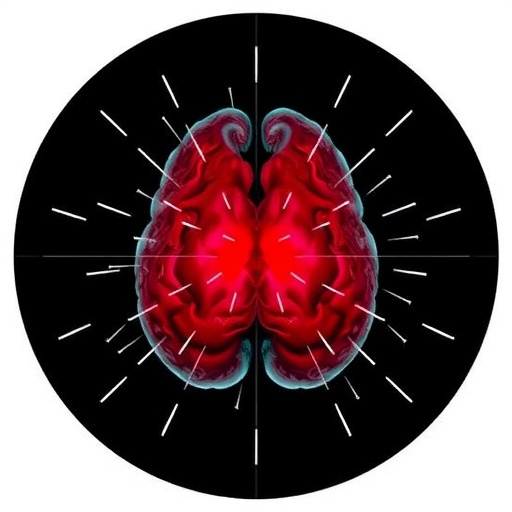Across the globe, haunted houses come alive each Halloween season, unleashing eerie figures that leap from shadows to startle visitors. These sudden, threatening apparitions trigger an intrinsic response within the human nervous system—an automatic freeze-then-flee reaction that has evolved over millennia to safeguard organisms from predators. While this innate threat response is crucial for survival in the wild, its dysregulation in modern humans often manifests as debilitating anxiety and stress disorders, highlighting an urgent need to decode the neural underpinnings of this primal alarm system.
A breakthrough study conducted by researchers at the University of Colorado Boulder has uncovered a previously obscure brain circuit pivotal to managing this freeze-flee response. Central to this mechanism is the interpeduncular nucleus (IPN), a compact but densely packed cluster of specialized neurons situated deep within the midbrain. This research not only identifies the IPN as a critical initiator of defensive reactions but intriguingly reveals its role in attenuating those responses when sensory input signals the absence of real danger. This ability to modulate threat perception underlies adaptive learning, allowing organisms—and humans in particular—to recalibrate their reactions based on experience.
The research team, led by graduate student Elora Williams and senior author Susanna Molas, designed an innovative experimental paradigm that mimicked a haunted house environment using mice as subjects. This elaborate setup involved projecting a looming, predator-like shadow intermittently above a maze where the mice navigated their surroundings. The looming stimulus, visually alarming and simulating overhead danger, reliably provoked a freezing episode during initial exposures—illustrating the innate action of the IPN in threat detection. Leveraging fiber photometry—a state-of-the-art technique employing genetically encoded fluorescent proteins—the scientists monitored neuronal activity within the IPN in real time as the mice encountered these visual threats.
The mice’s behavioral responses evolved remarkably over three consecutive days. On the first day, the sudden shadow induced immediate freezing, followed by escape into a corner shelter, mirroring the ingrained survival instinct. However, by day two, the rodents displayed reduced freezing duration, increased exploratory behavior, and shortened nest occupancy. By the third day, their reactions to the looming shadow markedly diminished, signaling learned habituation. Correspondingly, neuronal recordings revealed a parallel decline in IPN activity, specifically within GABAergic neurons responsible for propagating fear signals to broader brain circuits implicated in stress and anxiety regulation.
To confirm the causal role of IPN GABAergic neurons, the team harnessed optogenetics—a technique that provides exquisite temporal control over neuron firing using targeted light stimulation. When these inhibitory neurons were selectively silenced before presenting the threatening shadow, the mice displayed decreased freezing and less sheltering behavior, suggesting the neurons’ necessity for initiating defensive responses. Conversely, continuous activation of these neurons throughout the multi-day experiment prevented habituation, maintaining heightened alertness and persistent fear-like behaviors. This bidirectional manipulation underscored the IPN circuit’s essential function in balancing threat sensitivity and adaptive learning.
Historically, the amygdala and hippocampus have dominated neuroscience discourses on fear, threat detection, and memory consolidation related to aversive stimuli. This novel discovery of the IPN’s integral role adds complexity to our understanding of the brain’s fear network, situating the IPN as a vital mediator of innate defensive behaviors and their modulation over time. Unlike the amygdala’s well-characterized function in emotional processing, the IPN emerges as the neural gatekeeper switching the brain’s alarm system on and off, orchestrating the transition from acute fear to safety recognition.
The broader implications of this research touch on the neuropsychiatric realm, where malfunctioning threat circuits often manifest as persistent anxiety and post-traumatic stress disorder (PTSD). Dysregulated IPN functioning could explain why some individuals exhibit heightened fearfulness or impaired fear extinction, leading to chronic stress states. The findings also hint at the biological roots of individual differences in risk-taking behavior, suggesting that variability in IPN activity might underpin why certain people readily confront challenges while others shy away due to heightened threat sensitivity.
Future therapeutic avenues may emerge from these insights, as the IPN’s specific neuronal populations represent promising targets for pharmacological or neuromodulatory interventions. By precisely tuning IPN activity, clinicians could potentially recalibrate dysfunctional fear responses, alleviating symptoms in anxiety and trauma-related disorders. The technical sophistication of optogenetics in animal models foreshadows novel neuromodulation strategies in humans, such as targeted deep brain stimulation or advanced neurofeedback paradigms, aimed at restoring balanced threat processing.
This study represents a crucial stride toward unraveling how the brain distinguishes between genuine and false alarms, a function essential for mental health resilience. Understanding the neural choreography of freezing, fleeing, and eventual habituation sheds light on fundamental behavioral adaptation mechanisms that maintain psychological equilibrium in dynamic environments. As society grapples with rising mental health challenges, dissecting such primal circuits holds promise for breakthroughs in diagnosis, treatment, and prevention.
Additionally, the research team’s specialized methodology offers a blueprint for future studies investigating complex emotional behaviors using advanced imaging and genetic tools. The integration of behavioral paradigms that mimic naturalistic threats with real-time functional neuroimaging enables unprecedented exploration of deep brain structures traditionally inaccessible to conventional recording techniques. Such methodological innovations pave the way for comprehensive brain-wide mapping of dynamic threat networks.
In sum, the identification and characterization of the interpeduncular nucleus as a central node in threat processing and adaptive learning redefine the conceptual landscape of fear neuroscience. This discovery underscores the delicate balance between necessary vigilance and maladaptive anxiety, mediated through a precisely attuned neural circuit. With continued exploration, these insights may translate into transformative clinical applications, fostering better mental health outcomes and illuminating the biological essence of courage and caution.
Subject of Research: Animals
Article Title: Interpeduncular GABAergic neuron function controls threat processing and innate defensive adaptive learning.
News Publication Date: 8-Aug-2025
Web References: DOI link
Keywords: Anxiety disorders, Clinical psychology, Psychiatric disorders, Mental health, Psychological science




